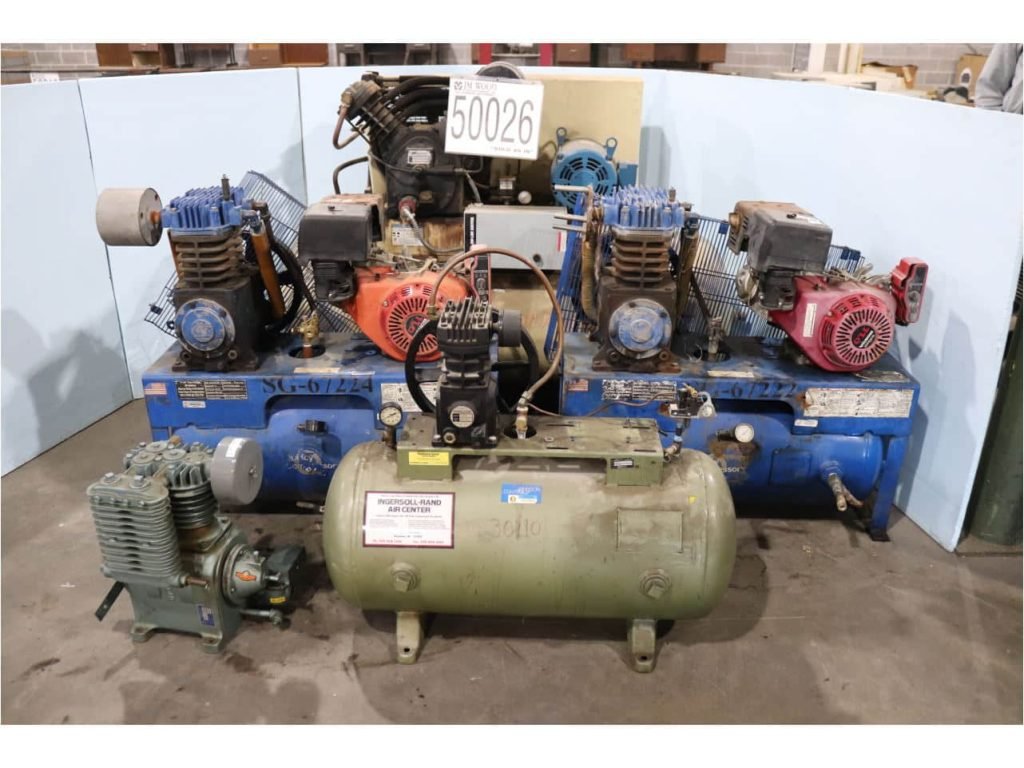When faced with the myriad of different types of compressors on the market, many users are unable to have a clear understanding of which compressor to choose. This is often due to a lack of complete understanding of the capabilities and performance of different compressors, leading to an inability to choose a reliable, efficient, and energy-saving compressor.
Based on the user’s specific situation and actual process requirements, an air compressor suitable for production needs should be selected. One should neither blindly choose a high-quality, high-priced model to avoid unnecessary expenses, nor simply choose an inferior model with frequent failures to save costs, as air compressors are important power equipment in industrial production.
Here’s a brief introduction to the advantages and disadvantages of commonly used compressors and their scope of application, hoping to provide a reference for users when choosing a compressor.
Compressors are typically divided into two main categories based on the way they compress gas: positive displacement and dynamic (also known as velocity) compressors. Due to the different structural forms of positive displacement and dynamic compressors, they are further classified as follows:
Screw compressor
The screw air compressor is a type of rotary positive displacement compressor, in which two rotors with helical gears mesh with each other to compress and expel gas. Screw air compressors are divided into single screw and twin screw according to the number, and divided into oil-injected and oil-free screw air compressors according to whether lubricating oil participates in the compression process. Oil-free compressors are further divided into dry type and water injection type.
Screw air compressors have a simple structure, few wearing parts, low exhaust temperature, and large compression ratio. They are particularly resistant to compression with liquid and dust in the gas. The appearance of oil-injected screw compressors has led to rapid development of screw compressors for power technology and refrigeration (including screw air compressors, screw refrigeration machines, etc.) both domestically and internationally.
Working Principle
The screw air compressor continuously generates compressed air by reducing the volume between the teeth of the male and female screw rotors and increasing the pressure of the gas through their meshing. The screw air compressor also belongs to the positive displacement compressor. Due to the working principle of the screw type, it is determined that compared to the piston air compressor, the screw air compressor has stable gas supply and generally does not need to be equipped with an air storage tank.
Main Advantages
- High reliability: Screw air compressors have few components and few wear parts, making them reliable and long-lasting.
- Easy to operate and maintain: Operators do not need to undergo long-term professional training, can realize unattended operation, the operation is relatively simple, and can supply gas according to the required exhaust volume.
- Good power balance: The screw air compressor has no unbalanced inertia force, and the machine can work smoothly at high speed, which can realize foundation-free operation. It is particularly suitable for use as a mobile compressor, with small size, light weight, and small footprint.
- Strong adaptability: The screw air compressor has the characteristic of forced air delivery, and the exhaust volume is almost unaffected by the exhaust pressure. It runs smoothly with little vibration, and the exhaust is stable. It can maintain high efficiency within a wide range.
- Multiphase mixed delivery: There is actually a gap between the rotor tooth surfaces of the screw air compressor, so it can withstand liquid shock and can pressurize and deliver liquid-containing gas, dust-containing gas, and easy-to-aggregate gas.
- Small volume of unit exhaust volume, saving floor space.
Although screw compressors have the above advantages, to keep the screw compressor running normally, safe and reliable, and have a long service life, a detailed maintenance plan must be formulated. It is best to implement fixed-person operation, regular maintenance, and regular inspection and maintenance to keep the compressor clean, oil-free, and dirt-free. Only a comprehensive grasp of maintenance knowledge and familiarity with troubleshooting methods can ensure the smooth operation of the compressor.
Main Disadvantages
Due to its strong balance, it can operate at high speed, so its power consumption is slightly higher.
After long-term operation, the gap between the screws will become larger, and the cost of regular repair or replacement is relatively large.
Application Scope
Screw compressors have unique advantages such as high reliability, convenient maintenance, and strong adaptability. With the continuous deepening of research and continuous improvement of design technology, the performance of screw compressors will be further improved, and their application fields will become more and more extensive. In addition to traditional applications, the application of screw compressors in new fields such as fuel and batteries will expand rapidly. At the same time, due to the continuous improvement of the reliability of screw compressors, they have gradually replaced reciprocating compressors in the medium refrigeration capacity range and have occupied part of the market for centrifugal compressors.
Development Trend
In the petrochemical field, domestic centrifugal compressors cannot meet domestic needs in high-tech and special products. There is still a gap in technical level, quality, and completeness compared with foreign countries. With the continuous expansion of China’s petrochemical production scale, centrifugal compressors will face new challenges in large-scale applications, and there is no mature experience in the design and manufacture of these large gas compressors. Due to the challenge of single-screw compressors, part of the twin-screw air compressor market will be squeezed by single-screw compressors. However, domestic twin-screw process compressors have always relied on imports, so twin-screw process compressors will be a development direction.
Centrifugal Compressor
A centrifugal compressor is a type of dynamic compressor in which one or more rotating impellers (usually with blades on the side) accelerate the gas, and the main airflow is radial. Dynamic compressors are divided into jet and turbo compressors, with centrifugal compressors falling into the latter category. In centrifugal compressors, the centrifugal force exerted by the high-speed rotating impeller and the expansion effect in the expansion channel increase the pressure of the gas.
Working Principle
Centrifugal air compressors work by having the impeller drive the gas to rotate at high speed, generating a centrifugal force. As the gas expands in the impeller, the speed and pressure of the gas increase after passing through the impeller, continuously producing compressed air. Centrifugal air compressors are velocity-type compressors and are stable and reliable when the load is steady.
Main Advantages
Large flow, high power, conducive to energy saving. The medium passing through the impeller of turbo machinery is continuous, the cylinder volume is large, and the impeller can rotate at high speed, so the exhaust flow and power generated by the turbo machinery can be greatly increased. Therefore, the exhaust of centrifugal compressors is even, and the airflow has no pulse.
Compact structure, good sealing effect, few leaks, small size, hence the floor area and weight of the unit are much smaller than the same air volume piston compressor.
Stable operation, reliable operation, therefore it has a high operating rate, a flat performance curve, a wide operating range, and low maintenance costs and personnel.
The compression process of a centrifugal compressor can be absolutely oil-free, and there is no need for lubrication inside the machine, which is important for many industries.
Few consumable parts, long running cycle, few and simple moving parts, and low manufacturing precision, so its manufacturing cost is relatively low and its reliability is high. It is easy to achieve automation and large-scale.
Main Disadvantages
Centrifugal compressors are currently not suitable for occasions with too small gas volume and too high pressure ratio.
The stable working area of the centrifugal compressor is relatively narrow, and although its air volume adjustment is relatively convenient, its economy is relatively poor. The airflow speed is high, and the parts in the flow channel have large friction losses.
The efficiency of centrifugal compressors is generally still lower than that of piston compressors. The adaptability of operation is poor, and the nature of the gas has a great impact on the operating performance. During the start-up, shutdown, and operation of the unit, the load changes greatly.
The centrifugal compressor has a high speed and may generate mechanical vibrations. In terms of operating characteristics, there will be surge phenomena, which are extremely harmful to the machine.
The operation is relatively complex, the gearbox noise is large, the equipment technology content is high, and the maintenance cost is large.
Application Scope
In recent years, with the establishment of chemical industries and large-scale chemical plants, centrifugal compressors have become key machines for compressing and conveying various gases in chemical production, occupying a very important position. As the achievements of gas dynamics research continue to improve the efficiency of centrifugal compressors, and the successful development of key technologies such as high-pressure sealing, narrow-impeller processing for small flow, and multi-oil wedge bearings, a series of problems in the development of centrifugal compressors to high pressure and wide flow range have been solved, greatly expanding the application range of centrifugal compressors, so that they can replace reciprocating compressors in many occasions, and greatly expanding their application range.
Some basic chemical raw materials, such as propylene, ethylene, butadiene, and benzene, can be processed into important chemical products such as plastics, fibers, and rubber. In petrochemical plants that produce these basic raw materials, centrifugal compressors also occupy an important position and are one of the key equipment. In addition, in other industries such as petroleum refining and refrigeration, centrifugal compressors are also extremely crucial equipment.
Development Trend
At present, centrifugal compressors can be used to compress and transport various gases in chemical production, and its exhaust pressure has been greatly improved compared to earlier times, and its minimum air volume has also been reduced, which has correspondingly expanded the application range of centrifugal compressors.
Centrifugal compressors need to develop towards large capacity to meet the ever-expanding scale of petrochemical production in our country. At the same time, with the development of new technologies and the emergence of new types of gas seals, magnetic bearings, and non-lubricated couplings, the development trend of centrifugal compressors is mainly manifested in: continuously developing high-pressure and small-flow products; further studying ternary flow theory and applying it to the design of components such as impellers and blade expanders, in order to achieve efficient units; low-noise, using noise protection to improve the operating environment.
Especially with the development of chemical and petrochemical production, the scale of production continues to increase, and centrifugal compressors, with their superior performance, are becoming increasingly widely used in many industrial fields, with a good development trend.
Piston Compressor
Piston compressors are the most common type of volumetric compressor. They use a crank-link mechanism to convert the rotary motion of the drive into the reciprocating motion of the piston. The piston and the cylinder together form the working chamber of the compressor, and the compressor relies on the reciprocating motion of the piston in the cylinder and the automatic opening and closing of the intake and exhaust valves to periodically allow gas into the cylinder working chamber for compression and discharge.
Piston compressors are mainly composed of three major parts: the motion mechanism (crankshaft, bearings, connecting rods, crosshead, pulley or coupling, etc.), the working mechanism (cylinder, piston, gas valve, etc.), and the body. There are also three auxiliary systems: the lubrication system, cooling system, and regulation system.
The movement mechanism is a crank-link mechanism that converts the rotary motion of the crankshaft into the reciprocating motion of the crosshead. The body is used to support and install the entire motion mechanism and working mechanism. The working mechanism is the main component to realize the working principle of the compressor.
Operating Principle
In pneumatic transmission, volumetric piston air compressors are usually used. Piston air compressors use the reciprocating motion of the piston driven by the crankshaft to continuously generate compressed air by compressing the gas in the cylinder chamber. Piston air compressors belong to volumetric compressors, and due to the working principle and characteristics of this type of machine, in order to stabilize the gas supply, general piston air compressors are equipped with air storage tanks.
Main Advantages
Wide range of applicable pressures. Since it works on the principle of volume change, no matter the size of its flow, it can reach a very high working pressure. Currently, low, medium, high, and ultra-high pressure compressors have been made, and the working pressure of ultra-high pressure compressors in industry can reach 350MPa (3500kgf/cm2).
Low equipment cost, less initial investment, easy operation, and long service life.
Because the compression process is a closed process, the thermal efficiency is relatively high.
Strong adaptability, wide range of exhaust volume, and less affected by changes in exhaust pressure. When the medium gravity changes, the changes in its volumetric displacement and exhaust pressure are also small.
Main Disadvantages
Large inertia force, speed cannot be too high, therefore the machine is relatively heavy, especially when the displacement is large.
The structure is complicated, there are many wearing parts, the maintenance workload is large, and the maintenance cost is relatively high.
The exhaust is not continuous, the air flow pressure pulsates, and column vibration is easy to occur.
The vibration and noise are large during operation, and the equipment installation base requirements are high.
Because piston machinery can only intermittently intake and exhaust, the cylinder volume is small, and the speed of the piston reciprocating motion cannot be too fast, therefore, the exhaust volume and power output of piston machinery are greatly limited.
Application Range
Piston compressors belong to a type of reciprocating compressor, and the pressure level belongs to medium pressure, high pressure, and ultra-high pressure levels. It is suitable for use in higher pressure situations, and the flow rate is mainly suitable for medium and small flow ranges, and in higher pressure situations.
Development Trend
Piston compressors are the most widely used compressors in traditional fields, but with the rise of other rotary compressors and other products, its market in many fields, such as refrigeration, is gradually shrinking.
The key ethylene construction project in the domestic petrochemical field and the vigorous rectification in.
Scroll Compressors
Scroll compressors have seen rapid development in the past decade, constituting a new highlight in compressor technology. Volumetric rotary scroll compressors, with their small size, high efficiency, and smooth operation, have received increasing attention and show great potential in small-scale applications. The advent of high-precision CNC milling machines has also brought development opportunities to scroll machinery.
Operating Principle
A scroll compressor consists of a fixed scroll and an orbiting scroll, a cross slide ring, a main shaft, a frame, and other main components. The scroll bodies or spirals of the fixed and orbiting scrolls are usually made up of uniform and identical involute curves, mounted in opposite directions, and phase-shifted by 180 degrees.
When the scroll compressor is operating, the orbiting scroll performs a planar circular motion (around the center of the main shaft) under the drive of the main shaft and the phase maintenance of the anti-rotation mechanism. As shown in the following diagram, a pair of working chambers completes one cycle of suction-compression-exhaust. The turning angle of the compression process varies with the number of spirals; the more spirals, the larger the turning angle. When the outermost suction chamber forms a closed volume and starts to advance towards the center, another new suction chamber simultaneously begins to form and repeats the above process. Therefore, regardless of the number of spirals, the compressor completes one cycle of suction and exhaust per revolution.
Main Advantages
Simple mechanism, small volume, light weight.
Few wear parts, high volumetric efficiency.
Machine friction is relatively small, so mechanical efficiency is high.
Multiple working chambers operate simultaneously, providing uniform torque.
Main Disadvantages
Like most rotary machinery, scroll machinery requires high precision for parts, so the cost of part manufacturing is high.
Poor performance under variable conditions, the working chamber cannot be externally cooled, making it difficult to dissipate heat.
Due to the restrictions of the working chamber seal and part strength conditions, the exhaust pressure is low.
Application Range
The field of air conditioning compressors is the most suitable field for scroll machinery in compressors, and it is also the field with the largest product output at present. Because scroll compressors have a relatively high pressure ratio, they are also suitable for refrigeration compressors. Scroll compressors with a larger compression process index are used for air compression and other gas compressions. Scroll machinery can also be used as vacuum pumps.
Development Trend
Scroll compressors currently have an absolute advantage in the field of cabinet air conditioning. In the field of automotive air conditioning, it has shown strong competitiveness. Its development lies in expanding its refrigeration capacity range, further improving efficiency, using alternative working substances, and reducing manufacturing costs.
Conclusion
With the development of China’s economy, China’s compressor design and manufacturing technology will also make rapid progress, and the technical level in some areas has reached the international advanced level. However, there is still a certain gap in some areas compared to the international advanced level.
It is hoped that compressor users can be realistic in their selection, combine enterprise needs, choose economical, reliable, efficient, and environmentally friendly compressors, and avoid problems such as machine maintenance and increased costs due to incorrect selection.
How to Select a Model
- Model selection should be based on needs.
- Calculation of working pressure.
- Calculation of air consumption.
- Determining the number and specifications of compressors.
- Operational analysis.
- Users need to consider their specific needs, potential future expansions, energy efficiency, spare parts standardization, and operating conditions when selecting a compressor model. By careful selection and operation, users can ensure that the compressor operates efficiently and economically, saving energy and reducing costs.
Your company is using an adsorption dryer to remove moisture from the air, which indicates high air quality requirements for your pneumatic equipment and tools.
When choosing a refrigerated dryer, you generally only need to match it to the flow rate of your air compressor. Select a dryer with a processing capacity equal to or slightly greater than the air compressor’s flow rate. If your company has high requirements for moisture in the air but does not need to use an adsorption dryer, you can either upgrade your refrigerated dryer or use two dryers in parallel.
For the selection of adsorption dryers:
Pressure Swing Adsorption (PSA): After using for a period, the desiccant will become saturated and need to be regenerated. The simplest and most common method is to divert some of the dried air from another tank, expand it after depressurization, and use it to dry the moist desiccant. For PSA, about 14% of the rated airflow is needed for complete regeneration.
Thermal Swing Adsorption (TSA): Another approach is to add some heating devices, like heating rods, to the desiccant tank. When regenerating the desiccant, you can raise its temperature to 200°C and use less regenerative air, saving a significant amount of energy. Only 4% of the regenerative air is needed for complete regeneration, saving about 10% of the compressed air volume. Generally, TSA is used in larger units or where compressed air flow is restricted. Although the initial investment is higher, it can save more costs in the long term.
Microthermal Regeneration: Microthermal regenerative adsorption dryers are a unique type of compressed air adsorption dryer in China. It was designed to combine the characteristics of heatless and heated dryers to produce a dryer with less regeneration air consumption than heatless and less heating power consumption than heated.
In conclusion, regardless of which of the above three options you choose, you need compressed air. When choosing the air compressor, you need to take into account the air needed for the regeneration of the desiccant in the dryer.
When choosing a pipeline filter, it typically only needs to be matched with the flow rate of your air compressor. Choose a filter with a processing capacity equal to or slightly larger than the flow rate of the air compressor.
Pipeline filters have different precisions, and the choice of precision depends on the company’s requirements for air quality. Currently, the market mainly uses screw air compressors and piston air compressors. Piston air compressors have an air oil content of 25-150PPM and require three-stage filtration. As for screw air compressors, the compressed air usually contains 2-3PPM of oil, so generally, two stages of filtration can meet the customer’s requirements for air quality. Of course, in special cases, we can also add an activated carbon filter for treatment.
As for the selection of the air storage tank, a simple method is 15-30% of the air output of the air compressor (in m3/min). If you want to calculate it, the following formula can be used.
V = Air tank volume;
Q = Air compressor air volume (m3/min);
8 = Constant (generally used at 7bar);
△P = Pressure difference (bar, usually set at least 0.6-1bar).
In addition, when choosing, you also need to determine the working pressure according to the customer’s needs, which not only meets the customer’s needs but also saves investment costs.




